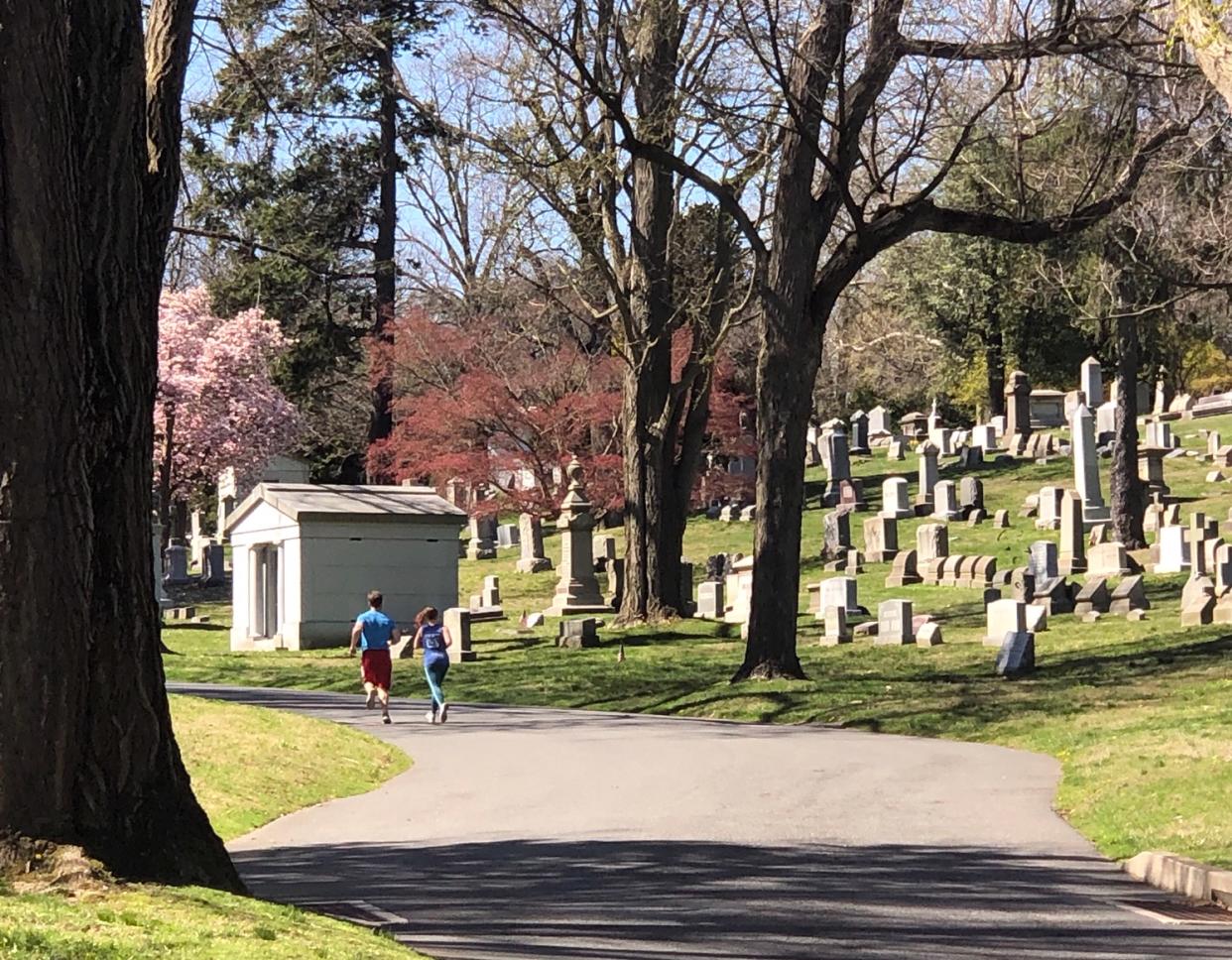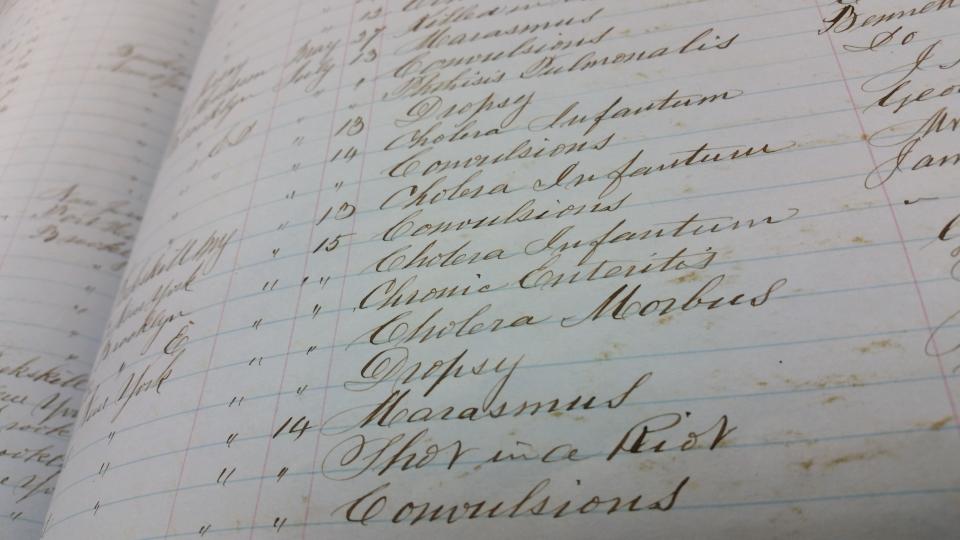Cemeteries see surge in visitors as people maintain social distancing amid coronavirus pandemic: ‘We need to get outside'

As cemeteries across the nation close their gates due to the coronavirus pandemic, some urban graveyards remain open, even extending their hours, to accommodate a surge in visitors seeking exercise and nature during stay-at-home mandates.
“To be honest, I don't think we would have ever taken the time to walk through that beautiful cemetery if our normal routines were not disrupted,” says Brittany Pitcher, who visited Laurel Hill Cemetery in Philadelphia recently with her husband and toddler son.
“Our numbers have really skyrocketed,” says Nancy Goldenberg, president and CEO of Laurel Hill Cemetery, as well as West Laurel Hill Cemetery in Bala Cynwyd, Pa. She says 43 percent of the year’s visitors came just in the last two weeks of March.
“I think more and more people, maybe in the past month, have suddenly realized how much they really do need open space that they might not have known, prior to the coronavirus pandemic,” she tells Yahoo Lifestyle.
And so far Goldenberg says social distancing hasn’t been a problem for visitors.
“It's 187 acres, so you can have a lot of people and it's still far apart,” she says. “Cemeteries are not like linear trails, where everybody is squeezed down into a 12-foot path. So that's the beauty of a cemetery.”
In Brooklyn, N.Y., the spike in visitors during the pandemic resulted in the 182-year-old Green-Wood Cemetery extending their hours and opening all four gates, when usually only two are open.
“We need this room and need the space. We need to get outside,” says Lisa Alpert, vice president of development and programming for Green-Wood Cemetery. “We feel that it would almost be irresponsible if we did not make that available to our own community, who is really seeking some time outside and some time to connect with nature.”
Alpert says the organization is incurring more costs to have the gates open and staffed with personnel to give out information and reinforce the importance of social distancing.
“And it is not something we take lightly at all. We understand what's at stake here at this time. No question about that. So safety is the most important thing to us and we have put extra measures in place to make sure that it is enforced and supported,” she says.
“I have spent a lot of time in Green-Wood Cemetery, and this was easily the largest number of people I have seen there outside of scheduled events,” says Laura Siegel, who visited earlier this week with her fiancé. “Under ordinary circumstances, even on a lovely spring day you could go a half [an] hour without running into another person there. I was also surprised to see a number of families with young children.”
“Everyone was wearing safety gear, including us. [Wearing] masks, gloves and keeping their distance,” says Brooklyn filmmaker Brendan McKnight, who visited Green-Wood earlier this week with his wife, Leslie.
The surge in visitors comes at a time when, Alpert says, cemetery operations have become “quite overwhelming” due to COVID-19 deaths.
“If there is a funeral, then that area's clearly blocked off,” she says, although there aren’t many group gatherings right now at the cemetery. And those that do gather follow the social distance mandates and remain 6 feet apart.
“The most active part of Green-Wood right now is sadly the crematory and that is in a separate building … separate from the paths and the landscape,” she says.
But not all cemeteries are keeping their gates open. Spring Grove Cemetery in Cincinnati, Ohio announced last week that it was closing its grounds to the general public due to “thousands” of new visitors to the cemetery during the pandemic.
And in New Orleans, where over 17,000 COVID-19 cases have been reported to date, the historic cemeteries are closed, except for certain hours for families in mourning.
But in Detroit, which has reported over 5,000 coronavirus cases, the grounds of many cemeteries remain open.
Caitlin Al-Ansari, a stay-at-home mom and Detroit native, says she’s visited five city cemeteries in the past few weeks during the pandemic. She says the parks have been overcrowded and she hasn’t been comfortable taking her children there.
“We do end up contemplating life and its meaning when we are there and I think it teaches you to appreciate the time you are given,” says Al-Ansari.
She says it’s been particularly poignant to see the graves of those who died in the 1918 flu pandemic. She recently visited the mausoleum of John and Horace Dodge at Woodlawn Cemetery in Detroit, who both died in 1920 due to complications from the flu. The brothers were car manufacturing pioneers who founded the Dodge Brothers Company, now the automaker Dodge.
“It's sad in a way to see the casualties, but it also inspires hope,” says Al-Ansari. “People did live, life went back to normal. It will for us too. So in that way it is comforting.”
“Cemeteries are an important and excellent record of the past, and a reminder that death is real,” says Jessica Ferri, author of a book on cemeteries, Silent Cities: New York. “But in this present moment, the graves that mark the victims of other pandemics are a reminder that we need to take these preventive measures seriously.”
Alpert says cemeteries are great keepers of history. Green-Wood has large, clothbound ledgers dating back to the first burial in 1840, recording names, place of birth, death, cause of death and more. She says that cemeteries shed light on the cycles of the city — including past pandemics.
“When you look at those archival records, you see other waves of influenza, cholera epidemics … that portray other difficult times for a city.”
Many cemeteries are also certified arboretums, including Green-Wood, Laurel Hill and West Laurel Hill cemeteries. Ferri calls them “park cemeteries.”

“‘Park’ cemeteries, like Green-Wood, in Brooklyn, were created with the implicit understanding that cemeteries functioned as parks and were meant for the living, to walk through,” says Ferri.
Alpert says the surge in visitors strolling in cemeteries isn’t a new phenomenon. Some 182 years ago when the cemetery opened, Central Park in New York City and Prospect Park in Brooklyn weren’t yet developed, so people would picnic at the cemetery.

In the 19th century, Alpert says there were some years where over half a million visitors would visit the cemetery. “It actually was the second-most-visited site in the United States next to Niagara Falls,“ she says.
In modern times, the ability to walk in nature has taken on a new level of enjoyment.
“It provides a little nature that's off the beaten path so we could keep our social distance,” says Rebecca Craig, the head cake chef at Cake Life Bake Shop in Philadelphia, who visited Laurel Hill Cemetery earlier this week. “We just wanted to see each other and get in some sunshine and fresh air. We are all cooped up lately and going a little stir-crazy.”
“It's spring and it's beautiful,” says Goldenberg. “ I'm really delighted that we're still able to keep our gates open so that people can experience our beautiful magnolia trees and the flowers that are blooming. It's spiritually uplifting to people. And I think at this time where everyone is so stressed, it's important.”
For the latest coronavirus news and updates, follow along at https://news.yahoo.com/coronavirus. According to experts, people over 60 and those who are immunocompromised continue to be the most at risk. If you have questions, please reference the CDC and WHO’s resource guides.
How to maintain your physical and mental health during the pandemic
Taking care of a loved one with COVID-19? Here’s how to stay healthy
Q&A with Dr. Kavita Patel: How to keep your family safe and maintain your mental health
Read more from Yahoo Lifestyle
Want daily pop culture news delivered to your inbox? Sign up here for Yahoo Entertainment & Lifestyle's newsletter.

